计算物理 ›› 2022, Vol. 39 ›› Issue (2): 127-142.DOI: 10.19596/j.cnki.1001-246x.8388
• 综述 • 下一篇
吕文娟1( ), 吴斌兵1(
), 吴斌兵1( ), 刘士炜2, 段皓3, 刘杰1,*(
), 刘士炜2, 段皓3, 刘杰1,*( )
)
收稿日期:2021-04-28
出版日期:2022-03-25
发布日期:2022-06-24
通讯作者:
刘杰
作者简介:吕文娟(1992-),女,博士研究生,研究方向为激光核物理,E-mail:lvwenjuan17@gscaep.ac.cn
吴斌兵(1992-),男,博士研究生,研究方向为激光物理,E-mail:wubinbing20@gscaep.ac.cn
基金资助:
Wenjuan LYU1( ), Binbing WU1(
), Binbing WU1( ), Shiwei LIU2, Hao DUAN3, Jie LIU1,*(
), Shiwei LIU2, Hao DUAN3, Jie LIU1,*( )
)
Received:2021-04-28
Online:2022-03-25
Published:2022-06-24
Contact:
Jie LIU
摘要:
超强激光技术的发展为光与物质相互作用的研究带来了历史性的机遇和拓展的空间。其中, 超强激光场辅助的原子核反应过程, 特别是对氘氚核聚变反应截面的影响越来越受到人们的关注。首先介绍近年来超强激光技术的发展及应用, 然后介绍核聚变反应截面及其影响因素, 重点综述超强激光场中轻核聚变反应截面的研究进展, 特别是强场增大氘氚核聚变截面的最新研究成果, 并展望这一研究方向的前沿发展。
吕文娟, 吴斌兵, 刘士炜, 段皓, 刘杰. 超强激光场中氘氚核聚变截面研究进展[J]. 计算物理, 2022, 39(2): 127-142.
Wenjuan LYU, Binbing WU, Shiwei LIU, Hao DUAN, Jie LIU. Progress in the Study of Deuteron-Triton Fusion Cross Sections in Superintense Laser Fields[J]. Chinese Journal of Computational Physics, 2022, 39(2): 127-142.

图1 以相对动能ε相互靠近的两个原子核之间的势能随距离的分区(图中U0为势阱深度的大小,rn和rmin分别为原子核接触半径与经典折返点。随着两个原子核的距离越来越近,依次经历(a) 波包接触过程、(b) 隧穿过程、和(c) 聚变过程,最终以一定几率发生聚变。)
Fig.1 Partition diagrams of potential-distance between two charged nuclei with relative kinetic energy ε (U0 is the depth of potential well. rn and rmin are the nuclear contact radius and the classical turning point, respectively. As the distance between the two nuclei gets closer and closer, they will go through three processes (a) wave packet contact process, (b) tunneling process and (c) fusion process in turn, and finally fuse with a certain probability.)
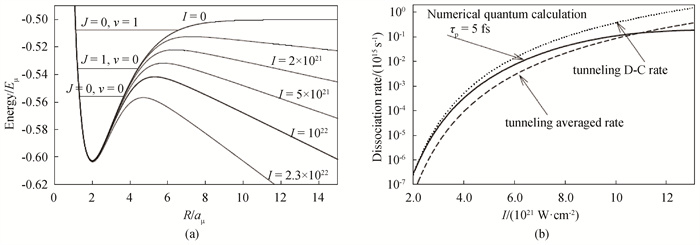
图3 (a) ddμ-在静电场中的势能面,电场振幅大小以相同的激光脉冲强度表示(Eμ=5.472 3 keV,aμ=0.263×10-12 m);(b) ddμ-的解离率随场强的变化[52]
Fig.3 (a) Potential energy surfaces of a ddμ- molecular ion in a range of static electric fields plotted as an intensity of a laser pulse with same electric field amplitude (Eμ=5.472 3 keV, aμ=0.263×10-12 m); (b) ddμ- dissociation rate versus the field strength of the sample[52]
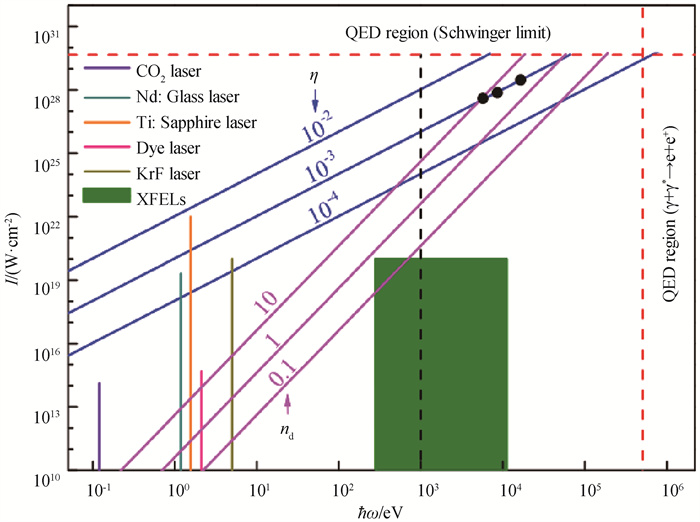
图4 目前已经实现的常用激光器的参数相图(竖直的黑色虚线代表激光频率为1 keV,蓝色实线分别代表η = 10-2,10-3和10-4,粉色实线分别代表nd= 0.1,1和10, 黑色的三个点是对应nd=3, 6, 9的激光参数点[8]。)
Fig.4 Phase diagram of laser parameters of currently achievable lasers (The vertical dashed black line represents a laser frequency of 1 keV. The solid blue lines denote η =10-2, 10-3 and 10-4. The solid pink lines denote nd= 0.1, 1, and 10. The black points are three typical laser parameters. Corresponding dimensionless parameters are nd= 3, 6, 9.[8])
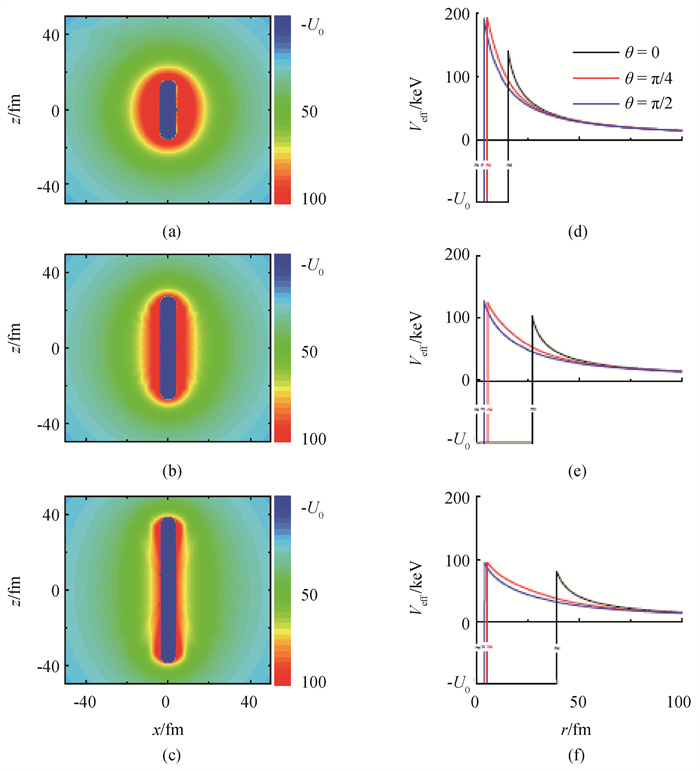
图5 有效势能关于z轴是旋转对称的。(a)~(c)分别为nd=3, 6, 9的x-z平面等高线,中心的蓝色区域为有效核势阱区域;(d)~(f)分别为相应的三个特殊夹角(θ=0, π/4, π/2)的有效势能[8]
Fig.5 The effective potential is rotational symmetry with respect to z axis. (a)-(c) Contour plots on x-z section of the effective potential at nd=3, 6, 9, respectively; (The blue areas represent the section of inner region Din.)(d)-(f) Veff at different angles (θ=0, π/4, π/2) with respect to nd[8]
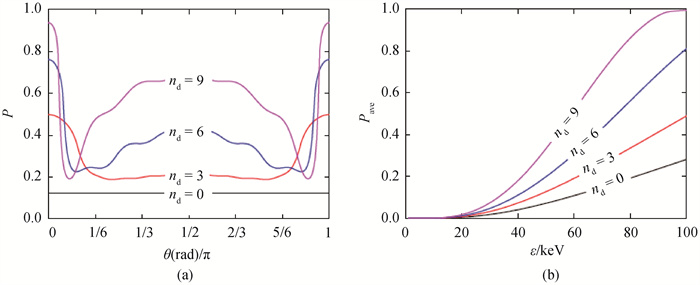
图6 nd=0, 3, 6, 9时,(a) 碰撞核相对动能为64 keV,隧穿率随外场偏振方向与粒子相对位置矢量的夹角θ的变化;(b) 对角度θ求平均后,隧穿率随碰撞核相对动能的变化[8]
Fig.6 At nd=0, 3, 6, 9, (a) angle-dependent penetrability for collision energy of ε=64 keV; (b) angle-averaged penetrability versus collision energy[8]
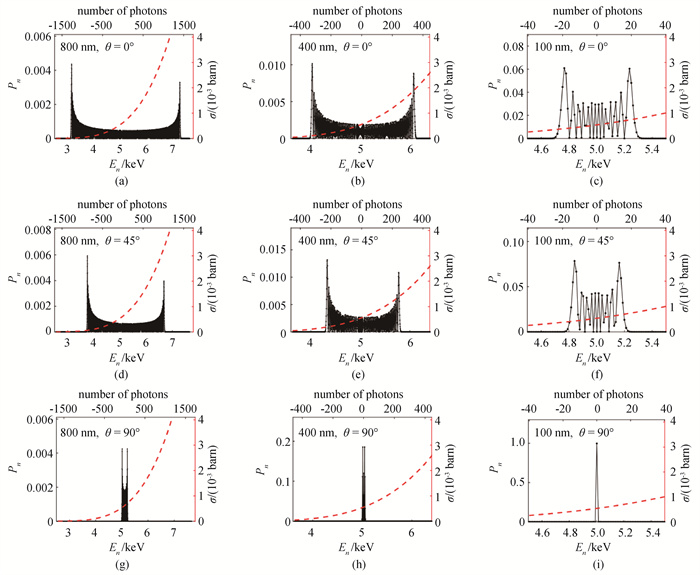
图8 强度为1020 W·cm-2,波长分别为800 nm,400 nm,100 nm的激光场中,以不同角度(θ = 0°, 45°, 90°) 入射的原子核的几率分布及对应的聚变截面(红色曲线)[53]
Fig.8 Probability distributions of particles that incident at different angles (θ = 0°, 45°, 90°) under different wavelengths (800 nm, 400 nm, 100 nm) of lasers with intensity 1020 W·cm-2 and corresponding fusion cross sections[53] (red curves)

图9 不同激光参数下,角度平均的氘氚聚变截面(水平点线代表没有外加激光场调制的氘氚聚变截面[53]。)
Fig.9 Angle-averaged fusion cross sections at different laser intensities and wavelengths (The horizontal dot lines represent fusion cross sections without laser field[53].)
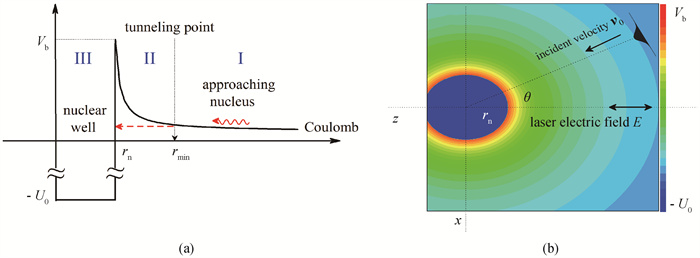
图10 (a) 氘氚聚变过程分为三个区域, Ⅰ:经典运动;Ⅱ:量子隧穿;Ⅲ:核聚变; (b) 氘氚碰撞过程的经典模拟示意图[54]
Fig.10 (a) The process of DT fusion is divided into three regions, Region Ⅰ: classical motion; Region Ⅱ: quantum tunneling; Region Ⅲ: nuclear fusion; (b) A schematic of classical simulations with an initial Gaussian distribution[54]
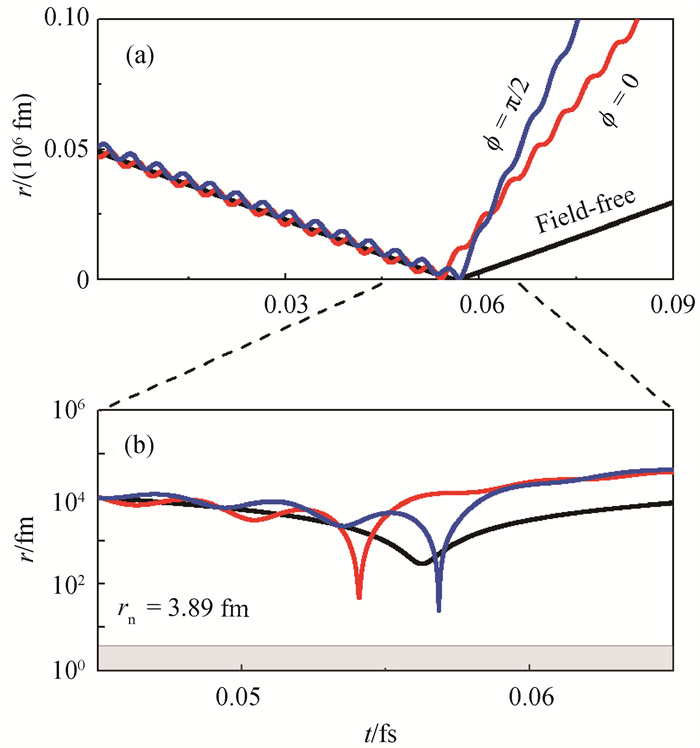
图11 (a) 激光场中氘氚碰撞的典型轨道示意图(黑色线为没有外场的轨道,红色线与蓝色线为不同激光场初始相位情况下的轨道。);(b)是(a)的局部放大图(参数为ε = 5 keV,I = 1024 W·cm-2, $\hbar \omega$ =10 eV。)
Fig.11 (a) Typical classical trajectories of a DT collision driven by laser field at ε=5 keV with different initial laser phases; (b) Zoom-in of the trajectory in (a) (Laser parameters are I=1024 W·cm-2, $\hbar \omega$ =10 eV.)

图13 (a)~(b) 不同激光频率下,氘氚聚变截面随激光场强的变化,初始能量ε=1 keV; (c)~(d) 不同初始能量下激光场增强氘氚聚变截面有效区域的相图
Fig.13 13 (a)-(b) Total fusion cross section with various laser intensities and frequencies obtained with the SC method (red circles). Others are presented for comparison: the KH results (olive lines) and the VSA results (blue dotted lines). The initial incident energy ε=1 keV. (c)-(d) Phase diagram of the effective region of laser-field-enhanced DT fusion cross sections at different initial energies
| 1 |
盛新志, 娄淑琴. 激光原理[M]. 第2版 北京: 清华大学出版社, 2015: 1- 12.
|
| 2 |
DOI |
| 3 |
周炳琨, 高以智, 陈倜嵘, 等. 激光原理[M]. 北京: 国防工业出版社, 2009: 210- 243.
|
| 4 |
DOI |
| 5 |
DOI |
| 6 |
李儒新. 上海超强超短激光实验装置研制进展[J]. 强激光与粒子束, 2020, 32 (1): 011002.
|
| 7 |
DOI |
| 8 |
DOI |
| 9 |
|
| 10 |
刘杰, 夏勤智, 傅立斌. 强激光场中的原子、分子与团簇[M]. 北京: 科学出版社, 2014: 1- 234.
|
| 11 |
|
| 12 |
|
| 13 |
|
| 14 |
|
| 15 |
|
| 16 |
DOI |
| 17 |
李子良, 努尔曼古丽·阿卜杜克热木, 谢柏松. 超强场下真空产生正负电子对的动理学方法研究及其进展[J]. 物理学进展, 2016, 36 (5): 129- 156.
|
| 18 |
DOI |
| 19 |
谢柏松, 李子良, 唐琐, 等. 超强场下的正负电子对产生[J]. 物理, 2017, 46 (11): 713- 720.
DOI |
| 20 |
DOI |
| 21 |
|
| 22 |
|
| 23 |
|
| 24 |
DOI |
| 25 |
DOI |
| 26 |
SCHWOERER H, BELEITES B, MAGILL J. Lasers and nuclei: Applications of ultrahigh intensity lasers in nuclear science[M]. WANG N Y, Transl. Harbin: Harbin Engineering University Press, 2019: 3-102.
|
| 27 |
王乃彦. 激光核物理[J]. 物理, 2008, 37 (9): 621- 624.
DOI |
| 28 |
马余刚. 原子核物理新进展[M]. 上海: 上海交通大学出版社, 2020: 377- 397.
|
| 29 |
DOI |
| 30 |
DOI |
| 31 |
DOI |
| 32 |
DOI |
| 33 |
DOI |
| 34 |
DOI |
| 35 |
DOI |
| 36 |
卢希庭, 江栋兴, 叶沿林. 原子核物理[M]. 第2版 北京: 原子能出版社, 2000: 97- 293.
|
| 37 |
DOI |
| 38 |
|
| 39 |
|
| 40 |
|
| 41 |
DOI |
| 42 |
DOI |
| 43 |
DOI |
| 44 |
DOI |
| 45 |
DOI |
| 46 |
DOI |
| 47 |
DOI |
| 48 |
DOI |
| 49 |
DOI |
| 50 |
|
| 51 |
|
| 52 |
|
| 53 |
DOI |
| 54 |
DOI |
| 55 |
刘士炜. 激光场中粒子碰撞的经典轨道动力学研究[D]. 北京: 中国工程物理研究院研究生院, 2020.
|
| 56 |
|
| 57 |
DOI |
| 58 |
DOI |
| 59 |
DOI |
| 60 |
DOI |
| 61 |
DOI |
| 62 |
|
| 63 |
DOI |
| [1] | 周历波, 叶涛, 王佳, 孙伟力. 4He系统的广义约化R矩阵理论分析[J]. 计算物理, 2022, 39(6): 631-640. |
| [2] | 常恒心, 许铮, 姚伟鹏, 谢雨, 乔宾. 量子电动力学—粒子模拟极端等离子体动力学研究[J]. 计算物理, 2017, 34(5): 526-542. |
| [3] | 陈民, 盛政明, 郑君, 马燕云, 张杰. 粒子模拟程序的发展及其在激光等离子体相互作用研究中的应用[J]. 计算物理, 2008, 25(1): 43-50. |
| 阅读次数 | ||||||
|
全文 |
|
|||||
|
摘要 |
|
|||||
版权所有 © 《计算物理》编辑部
地址:北京市海淀区丰豪东路2号 邮编:100094 E-mail:jswl@iapcm.ac.cn
本系统由北京玛格泰克科技发展有限公司设计开发
